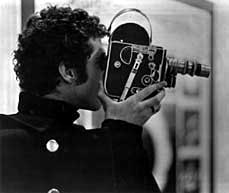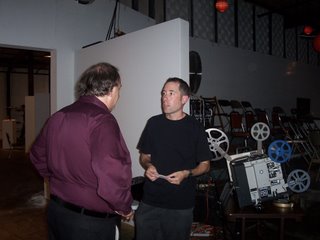Frequent Small Meals + Warren Sonbert


A colleague, Andy Ditzler, musician and media librarian, is also a host of a monthly film program at Eyedrum Gallery in Atlanta. Ditzler is a rare film lover, and his program FILM LOVE, produced by Frequent Small Meals (FSM), screens rarely seen films with extensive program notes which are available on the FSM website. Last week he exhibited short films by Warren Sonbert (pictured left). Sonbert, who died from complications from AIDS in 1995, was one of the New York downtown art darlings of the 1960s whose early works documented his view of that world. With his unique, thematic aggregate-image editing style, Sonbert has been considered a master of avant-gard cinema. Unfortunately, until recently his films have not been available for screening. Fortunately the Estate Project for Artists with AIDS, has made restoring his works a priority. Much of his early work concerns his New York life, later works are more varied with images from his international travels. Many of the images in a later work Honor and Obey (1988) capture dynamics between people, sharp accusations, frustration, humor, avoidance, it's a less stylized and constructed version of what Bill Viola would do decades later in his video
 art. Ditzler (pictured below right) showed two of Sonbert's early works Amphetamine (1966) and Where Did Our Love Go? (1966) plus two later works, Honor and Obey (1988), and what is considered his most accomplished work, Friendly Witness (1989). Being a sound freak, and something of a Michel Chion afficionado, I can't get with Sonbert's argument that sound and image don't go together, although I don't disagree that images have their own rhythm, it's just that those rhythms often have attendant sound and vice versa. Not surprising then that I grooved on the first two works more than Honor and Obey--although that work evidenced some compellingly quixotic editing poetics. Sadly, the program ran longer than I expected and I had to leave missing Friendly Witness which I can only hope to see at another juncture. But here's the thing, Amphetamine gives a discrete view of young gay white men shooting up, yes, speed, in an apartment while the soundtrack plays endless Supreme cuts, with their white-pop crossover sound. In its time these scenes of drug use and mundane homosexuality (boys kissing, sitting dazedly, reading books, and doing drugs) were shocking and even now seem so with boys slowly (and I mean slowly) injecting themselves using syringes with vacuum bulb heads, given that Sonbert was only 19 years old in 1966, but also is terribly sad, and a harbinger of the horrible storm that was to come 20 years later. Even the sweet moments of two men giving a full mouthed kiss as Sonbert's camera joyous circles them, and then captures a glimpse of furtive lovemaking and later the drug-addled afterglow, felt elegiac. The real discovery for me was with Where Did Our Love Go? and its potent utilization of the teen-tough girl/Maria Callas pre-performance art pop-dynamics of The Shangri-Las, in particular "He Cried" (a 1966 reworking of Jay & the Americans "She Cried"), and "Past, Present, and Future"(1966) which weaves angst, love, and ennui into spoken word monologue recited over Beethoven's "Moonlight Sonata". These played over informal images of the formal space of the art museum where you couldn't quite imagine the tight leather and go-go boot motorcycle chick look of the Shangra-Las fitting in but then moves to the land of Warhol and a rare 360 degree view of The Factory in full-party and down-time creative mode. I had really forgotten how white that world was and suddenly remembered that Andy Warhol had a rather dim view of African American intellectual and creative ability. (Racism: it's an all purpose eraser. First no art world head table (read:white) folks will acknowledge your avant-garde work due to their belief that black people don't do that and then when they see the evidence of the success of that racist application--the absence of such work--use that to explain how black people don't do that work.) Fortunately, as artist Cauleen Smith reminded me this weekend, that art world dynamic is much better than it used to be. Racial exclusivity notwithstanding, it was interesting to see Sonbert's eye, ear, and editing.
art. Ditzler (pictured below right) showed two of Sonbert's early works Amphetamine (1966) and Where Did Our Love Go? (1966) plus two later works, Honor and Obey (1988), and what is considered his most accomplished work, Friendly Witness (1989). Being a sound freak, and something of a Michel Chion afficionado, I can't get with Sonbert's argument that sound and image don't go together, although I don't disagree that images have their own rhythm, it's just that those rhythms often have attendant sound and vice versa. Not surprising then that I grooved on the first two works more than Honor and Obey--although that work evidenced some compellingly quixotic editing poetics. Sadly, the program ran longer than I expected and I had to leave missing Friendly Witness which I can only hope to see at another juncture. But here's the thing, Amphetamine gives a discrete view of young gay white men shooting up, yes, speed, in an apartment while the soundtrack plays endless Supreme cuts, with their white-pop crossover sound. In its time these scenes of drug use and mundane homosexuality (boys kissing, sitting dazedly, reading books, and doing drugs) were shocking and even now seem so with boys slowly (and I mean slowly) injecting themselves using syringes with vacuum bulb heads, given that Sonbert was only 19 years old in 1966, but also is terribly sad, and a harbinger of the horrible storm that was to come 20 years later. Even the sweet moments of two men giving a full mouthed kiss as Sonbert's camera joyous circles them, and then captures a glimpse of furtive lovemaking and later the drug-addled afterglow, felt elegiac. The real discovery for me was with Where Did Our Love Go? and its potent utilization of the teen-tough girl/Maria Callas pre-performance art pop-dynamics of The Shangri-Las, in particular "He Cried" (a 1966 reworking of Jay & the Americans "She Cried"), and "Past, Present, and Future"(1966) which weaves angst, love, and ennui into spoken word monologue recited over Beethoven's "Moonlight Sonata". These played over informal images of the formal space of the art museum where you couldn't quite imagine the tight leather and go-go boot motorcycle chick look of the Shangra-Las fitting in but then moves to the land of Warhol and a rare 360 degree view of The Factory in full-party and down-time creative mode. I had really forgotten how white that world was and suddenly remembered that Andy Warhol had a rather dim view of African American intellectual and creative ability. (Racism: it's an all purpose eraser. First no art world head table (read:white) folks will acknowledge your avant-garde work due to their belief that black people don't do that and then when they see the evidence of the success of that racist application--the absence of such work--use that to explain how black people don't do that work.) Fortunately, as artist Cauleen Smith reminded me this weekend, that art world dynamic is much better than it used to be. Racial exclusivity notwithstanding, it was interesting to see Sonbert's eye, ear, and editing.

0 Comments:
Post a Comment
<< Home